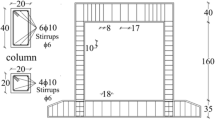Abstract
To assess the seismic performance of buildings reinforced by steel moment frames using built-in or external indirect joints, shear strength of indirect joints to be applied to computer-aided structural numerical models is required. However, Korea’s earthquake provisions do not provide the specified shear strength of indirect joints of specific seismic strengthened methods. In this study, an experiment was conducted to investigate the shear strength of indirect joints in the built-in and external seismic strengthened methods with specific indirect joints. It was confirmed that the shear strength of the indirect joint was determined to be a conservative value among the interfacial shear force of the post-installed anchor and the shear strength of the load transfer part. It was also confirmed that the indirect joint exhibited the same shear strength regardless of the type of seismic reinforcement, and the shear strength of the indirect joint was provided. In addition, a method of calculating the shear strength depending on the number of load transfer parts and the thickness of indirect joints was proposed.











Similar content being viewed by others
References
ACI. (2006). Committee 374, 374.1-05: Acceptance Criteria for Moment Frames based on Structural Testing and Commentary. American Concrete Institute.
ACI. (2014). Committee 318, 318–14: Building code requirements for structural concrete and commentary. American Concrete Institute.
Chen, W., Shou, W., & Cui, S. (2019). Seismic performance of non-ductile R.C. frames strengthened with CFRP. Composite Structures, 221, 110870.
Federal Emergency Management Agency (FEMA). (1992). NEHRP handbook of techniques for the seismic rehabilitation of existing buildings. Federal Emergency Management Agency.
Federal Emergency Management Agency (FEMA). (2006). Techniques for the seismic rehabilitation of existing buildings. Federal Emergency Management Agency.
HILTI Corporation. (2012). Operating instruction HILTI HIT-CT 1 with HIT-V. HILTI Corporation.
Hu, B., Lv, H. L., & Kundu, T. (2019). Experimental study on seismic behavior of reinforced concrete frame in primary and middle schools with different strengthening methods. Construction and Building Materials, 217, 473–486.
Japan Building Disaster Prevention Association (JBDPA). (2017). Japanese seismic design code and guidelines of seismic retrofit and commentary of existing reinforced concrete buildings. JBDPA. (in Japanese).
Kim, S. (2021a). Seismic retrofitting effect of R.C. buildings using perimeter steel moment frames. International Journal of Steel Structures, 21, 757–770.
Kim, S. (2021b). Shear strength investigation of connections between RC and strengthened steel frames. International Journal of Steel Structures, 21, 1845–1858.
Korean Education Development Institute (KEDI). (2011). Development of guideline for seismic evaluation and rehabilitation of existing school buildings in Korea (CR2011-41). KEDI. (in Korean).
Korean Ministry of Education (KMOE). (2020). Seismic Design Code of Korean School Facilities (KME Notice No. 2020–223). KME. (in Korean).
Korean Ministry of Education (KMOE). (2019). Manual of seismic performance evaluation and retrofit of Korean school facilities. KME. (in Korean).
Korean Ministry of Land, & Infrastructure and Transport (KMOLIT). (2019). Korean design standard: KDS 41. KMOLIT. (in Korean).
Korean Ministry of the Interior and Safety (KMOIS). (2018). Establishment of master plan for Korean seismic design and retrofit. KMOIS. (in Korean).
Lee, C. H., Ryu, J., Kim, D. H., & Ju, Y. K. (2018). Improving seismic performance of non-ductile reinforced concrete frames through the combined behavior of friction and metallic dampers. Engineering Structures, 172, 304–320.
Union Corporation. (2017). Union Grout PAD·EM·GM·HS·JM-CAT.NO.9:94.07, Union Corporation (in Korean).
Zahrai, S. M., & Cherahi, A. (2017). Reducing seismic vibrations of typical steel buildings using new multi-level yielding pipe damper. International Journal of Steel Structures, 17(3), 983–998.
Acknowledgements
This paper was provided by the 2022 Youngsan University Research Fund.
Author information
Authors and Affiliations
Corresponding author
Additional information
Publisher’s Note
Springer Nature remains neutral with regard to jurisdictional claims in published maps and institutional affiliations.
Rights and permissions
Springer Nature or its licensor (e.g. a society or other partner) holds exclusive rights to this article under a publishing agreement with the author(s) or other rightsholder(s); author self-archiving of the accepted manuscript version of this article is solely governed by the terms of such publishing agreement and applicable law.
About this article
Cite this article
Kim, S. Experimental Study on Shear Strength of Indirect Joint Strengthened by Steel Moment Frames. Int J Steel Struct 23, 1329–1342 (2023). https://doi.org/10.1007/s13296-023-00771-x
Received:
Accepted:
Published:
Issue Date:
DOI: https://doi.org/10.1007/s13296-023-00771-x




